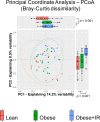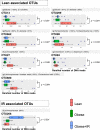Depletion of Blautia Species in the Microbiota of Obese Children Relates to Intestinal Inflammation and Metabolic Phenotype Worsening
- PMID: 32209719
- PMCID: PMC7093825
- DOI: 10.1128/mSystems.00857-19
Depletion of Blautia Species in the Microbiota of Obese Children Relates to Intestinal Inflammation and Metabolic Phenotype Worsening
Abstract
Cross-sectional studies conducted with obese and control subjects have suggested associations between gut microbiota alterations and obesity, but the links with specific disease phenotypes and proofs of causality are still scarce. The present study aimed to profile the gut microbiota of lean and obese children with and without insulin resistance to characterize associations with specific obesity-related complications and understand the role played in metabolic inflammation. Through massive sequencing of 16S rRNA gene amplicons and data analysis using a novel permutation approach, we have detected decreased incidence of Blautia species, especially Blautia luti and B. wexlerae, in the gut microbiota of obese children, which was even more pronounced in cases with both obesity and insulin resistance. There was also a parallel increase in proinflammatory cytokines and chemokines (gamma interferon [IFN-γ], tumor necrosis factor alpha [TNF-α], and monocyte chemoattractant protein 1 [MCP-1]) in feces of obese children compared to those of lean ones. B. luti and B. wexlerae were also shown to exert an anti-inflammatory effect in peripheral blood mononuclear cell cultures in vitro, compared to non-obesity-associated species. We suggest that the depletion of B. luti and B. wexlerae species in the gut ecosystem may occur in cases of obesity and contribute to metabolic inflammation leading to insulin resistance.IMPORTANCE Child obesity constitutes a risk factor for developing insulin resistance which, if sustained, could lead to more severe conditions like type 2 diabetes (T2D) in adulthood. Our study identified previously unknown species whose depletion (Blautia luti and Blautia wexlerae) is associated with insulin resistance in obese individuals. Our results also indicate that these bacterial species might help to reduce inflammation causally linked to obesity-related complications. Childhood is considered a window of opportunity to tackle obesity. These new findings provide, therefore, valuable information for the future design of microbiota-based strategies for the early prevention of obesity-related complications.
Keywords: Blautia luti; Blautia wexlerae; PBMCs; childhood obesity; children; gut inflammation; gut microbiota; inflammation; insulin resistance; microbiota; obesity; permubiome; probiotics.
Copyright © 2020 Benítez-Páez et al.
Figures



Similar articles
-
Quantification of Blautia wexlerae and Blautia luti in human faeces by real-time PCR using specific primers.Benef Microbes. 2015;6(4):583-90. doi: 10.3920/BM2014.0133. Epub 2015 Apr 22. Benef Microbes. 2015. PMID: 25691104
-
Reclassification of Clostridium coccoides, Ruminococcus hansenii, Ruminococcus hydrogenotrophicus, Ruminococcus luti, Ruminococcus productus and Ruminococcus schinkii as Blautia coccoides gen. nov., comb. nov., Blautia hansenii comb. nov., Blautia hydrogenotrophica comb. nov., Blautia luti comb. nov., Blautia producta comb. nov., Blautia schinkii comb. nov. and description of Blautia wexlerae sp. nov., isolated from human faeces.Int J Syst Evol Microbiol. 2008 Aug;58(Pt 8):1896-902. doi: 10.1099/ijs.0.65208-0. Int J Syst Evol Microbiol. 2008. PMID: 18676476
-
Modulation of Gut Microbiota Metabolism in Obesity-Related Type 2 Diabetes Reduces Osteomyelitis Severity.Microbiol Spectr. 2022 Apr 27;10(2):e0017022. doi: 10.1128/spectrum.00170-22. Epub 2022 Mar 22. Microbiol Spectr. 2022. PMID: 35315698 Free PMC article.
-
The Ambiguous Correlation of Blautia with Obesity: A Systematic Review.Microorganisms. 2024 Aug 26;12(9):1768. doi: 10.3390/microorganisms12091768. Microorganisms. 2024. PMID: 39338443 Free PMC article. Review.
-
The gut microbiota, obesity and insulin resistance.Mol Aspects Med. 2013 Feb;34(1):39-58. doi: 10.1016/j.mam.2012.11.001. Epub 2012 Nov 16. Mol Aspects Med. 2013. PMID: 23159341 Review.
Cited by
-
Western diet contributes to the pathogenesis of non-alcoholic steatohepatitis in male mice via remodeling gut microbiota and increasing production of 2-oleoylglycerol.Nat Commun. 2023 Jan 16;14(1):228. doi: 10.1038/s41467-023-35861-1. Nat Commun. 2023. PMID: 36646715 Free PMC article.
-
Soybean protein concentrate causes enteritis in juvenile pearl gentian groupers (Epinephelus fuscoguttatus ♀ × Epinephelus lanceolatus ♂).Anim Nutr. 2022 Aug 17;12:171-185. doi: 10.1016/j.aninu.2022.08.006. eCollection 2023 Mar. Anim Nutr. 2022. PMID: 36712400 Free PMC article.
-
The Relationship Between Pediatric Gut Microbiota and SARS-CoV-2 Infection.Front Cell Infect Microbiol. 2022 Jul 8;12:908492. doi: 10.3389/fcimb.2022.908492. eCollection 2022. Front Cell Infect Microbiol. 2022. PMID: 35873161 Free PMC article.
-
Dysbiosis of Gut Microbiota and Intestinal Barrier Dysfunction in Pigs with Pulmonary Inflammation Induced by Mycoplasma hyorhinis Infection.mSystems. 2022 Aug 30;7(4):e0028222. doi: 10.1128/msystems.00282-22. Epub 2022 Jun 14. mSystems. 2022. PMID: 35699454 Free PMC article.
-
Temporal Dynamics of the Intestinal Microbiome Following Short-Term Dietary Restriction.Nutrients. 2022 Jul 6;14(14):2785. doi: 10.3390/nu14142785. Nutrients. 2022. PMID: 35889742 Free PMC article.
References
-
- World Health Organization. 2018. Fact sheet on obesity and overweight.
-
- Juonala M, Magnussen CG, Berenson GS, Venn A, Burns TL, Sabin MA, Srinivasan SR, Daniels SR, Davis PH, Chen W, Sun C, Cheung M, Viikari JS, Dwyer T, Raitakari OT. 2011. Childhood adiposity, adult adiposity, and cardiovascular risk factors. N Engl J Med 365:1876–1885. doi:10.1056/NEJMoa1010112. - DOI - PubMed
-
- World Health Organization. 2018. Childhood Obesity Surveillance Initiative (COSI) factsheet.
LinkOut - more resources
Full Text Sources
Other Literature Sources
Molecular Biology Databases
Research Materials
Miscellaneous
